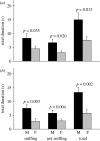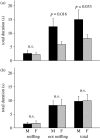Encoding choosiness: female attraction requires prior physical contact with individual male scents in mice
- PMID: 18448415
- PMCID: PMC2587794
- DOI: 10.1098/rspb.2008.0302
Encoding choosiness: female attraction requires prior physical contact with individual male scents in mice
Abstract
Scents, detected through both the main and vomeronasal olfactory systems, play a crucial role in regulating reproductive behaviour in many mammals. In laboratory mice, female preference for airborne urinary scents from males (detected through the main olfactory system) is learnt through association with scents detected through the vomeronasal system during contact with the scent source. This may reflect a more complex assessment of individual males than that implied by laboratory mouse studies in which individual variation has largely been eliminated. To test this, we assessed female preference between male and female urine using wild house mice with natural individual genetic variation in urinary identity signals. We confirm that females exhibit a general preference for male over female urine when able to contact urine scents. However, they are only attracted to airborne urinary volatiles from individual males whose urine they have previously contacted. Even females with a natural exposure to many individuals of both sexes fail to develop generalized attraction to airborne male scents. This implies that information gained through contact with a specific male's scent is essential to stimulate attraction, providing a new perspective on the cues and olfactory pathways involved in sex recognition and mate assessment in rodents.
Figures



Similar articles
-
Female recognition and assessment of males through scent.Behav Brain Res. 2009 Jun 25;200(2):295-303. doi: 10.1016/j.bbr.2008.12.020. Epub 2008 Dec 25. Behav Brain Res. 2009. PMID: 19146884 Review.
-
Darcin: a male pheromone that stimulates female memory and sexual attraction to an individual male's odour.BMC Biol. 2010 Jun 3;8:75. doi: 10.1186/1741-7007-8-75. BMC Biol. 2010. PMID: 20525243 Free PMC article.
-
Refining the dual olfactory hypothesis: pheromone reward and odour experience.Behav Brain Res. 2009 Jun 25;200(2):277-86. doi: 10.1016/j.bbr.2008.10.002. Epub 2008 Oct 11. Behav Brain Res. 2009. PMID: 18977394 Review.
-
Role of the vomeronasal system in intersexual attraction in female mice.Neuroscience. 2008 May 2;153(2):383-95. doi: 10.1016/j.neuroscience.2008.02.002. Epub 2008 Feb 13. Neuroscience. 2008. PMID: 18384964
-
Effects of vomeronasal organ removal on olfactory sex discrimination and odor preferences of female ferrets.Chem Senses. 2004 Oct;29(8):659-69. doi: 10.1093/chemse/bjh069. Chem Senses. 2004. PMID: 15466811 Free PMC article.
Cited by
-
Selection on Coding and Regulatory Variation Maintains Individuality in Major Urinary Protein Scent Marks in Wild Mice.PLoS Genet. 2016 Mar 3;12(3):e1005891. doi: 10.1371/journal.pgen.1005891. eCollection 2016 Mar. PLoS Genet. 2016. PMID: 26938775 Free PMC article.
-
Neural and Hormonal Basis of Opposite-Sex Preference by Chemosensory Signals.Int J Mol Sci. 2021 Aug 2;22(15):8311. doi: 10.3390/ijms22158311. Int J Mol Sci. 2021. PMID: 34361077 Free PMC article. Review.
-
Oxytocin signaling in the medial amygdala is required for sex discrimination of social cues.Elife. 2017 Dec 12;6:e31373. doi: 10.7554/eLife.31373. Elife. 2017. PMID: 29231812 Free PMC article.
-
Chemosignals, hormones and mammalian reproduction.Horm Behav. 2013 May;63(5):723-41. doi: 10.1016/j.yhbeh.2013.03.011. Epub 2013 Mar 29. Horm Behav. 2013. PMID: 23545474 Free PMC article. Review.
-
Analysis of male pheromones that accelerate female reproductive organ development.PLoS One. 2011 Feb 8;6(2):e16660. doi: 10.1371/journal.pone.0016660. PLoS One. 2011. PMID: 21347429 Free PMC article.
References
-
- Alder S. Origin of the golden hamster (Cricetus auratus) as a laboratory animal. Nature. 1948;162:256–257. doi:10.1038/162256b0 - DOI - PubMed
-
- Andersson M. Princeton University Press; Princeton, NJ: 1994. Sexual selection.
-
- Andersson M, Simmons L.W. Sexual selection and mate choice. Trends Ecol. Evol. 2006;21:296–302. doi:10.1016/j.tree.2006.03.015 - DOI - PubMed
-
- Beck J.A, Lloyd S, Hafezparast M, Lennon-Pierce M, Eppig J.T, Festing M.F, Fisher E.M. Genealogies of mouse inbred strains. Nat. Genet. 2000;24:23–25. doi:10.1038/71641 - DOI - PubMed
-
- Boyse E.A, Beauchamp G.K, Yamazaki K. The genetics of body scent. Trends Genet. 1987;3:97–102. doi:10.1016/0168-9525(87)90192-2 - DOI
Publication types
MeSH terms
Grants and funding
LinkOut - more resources
Full Text Sources
Medical

